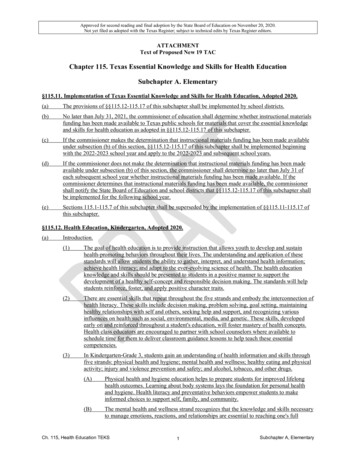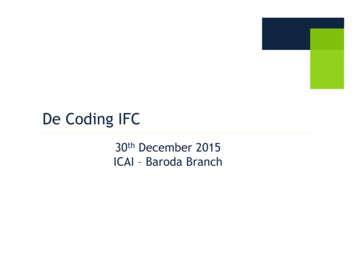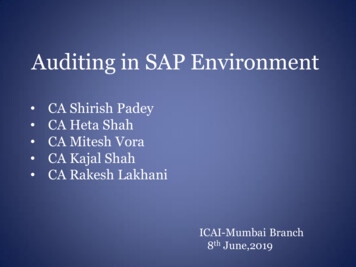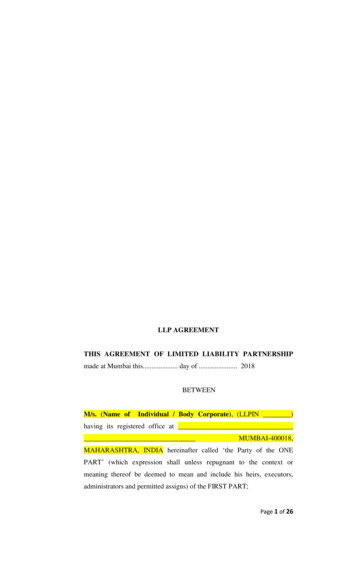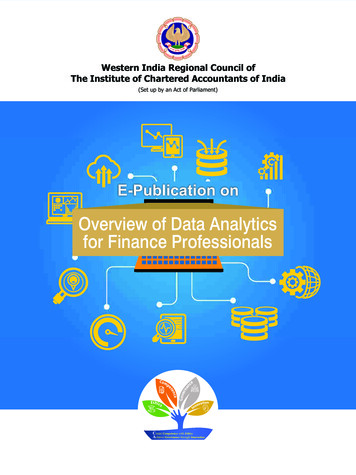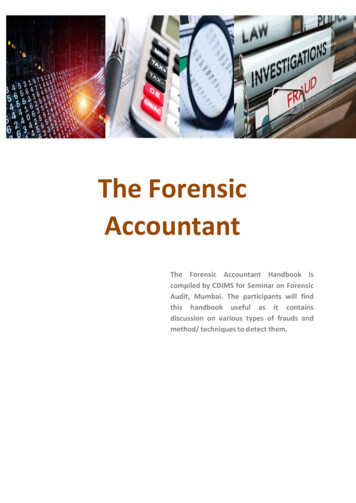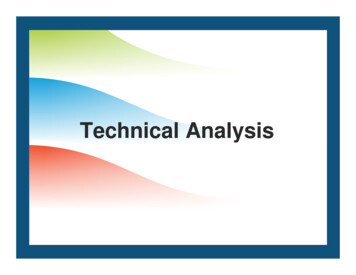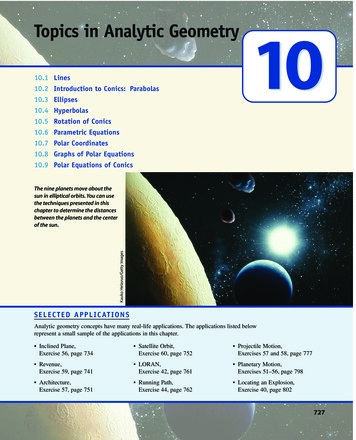
Transcription
Ind AS 115(Revenue from contracts with customers)PresentedbyCA Manoj Pati
Contents Background5 step model of revenue recognitionRecognition & Measurement – over time or at a point in time
Background IASB adopted IAS 18 “Revenue” in 2001 revised in 1993 by the IASC Revenuestandard originally issued in 1982.IFRS 15 issued In May 2014 as part of a joint effort by the IASB and the FASBFrom Indian perspective it is applicable for accounting years beginning April 1, 2018.2 methods of transitional provisions: full retrospective application, i.e. standard would be applicable from April 1, 2017 apply effect only to the opening balance of retained earnings on April 1, 2018
Background In addition to IAS 18, it replaces the following standards/interpretations IAS 11 : Accounting for Construction Contracts SIC 31 : Revenue – Barter Transactions Involving Advertising Services IFRIC 13 : Customer Loyalty Programmes IFRIC 15 : Agreements for the Constructions of Real Estate IFRIC 18 : Transfer of Assets from CustomersThe revised standard has been issued because US GAAP and IFRS had different revenue recognition criteria Needed improvement. Deemed to be difficult to apply in complex transactions Provided limited guidance on certain topics (multiple element arrangements inIFRS, US GAAP had guidance for specific transactions & industries leading toapplication differences)
Scope Ind AS 115 specifically excludes from its scope certain type of transactions: Leases in the scope of Ind AS 17 / Ind AS 116 Insurance contracts in the scope of Ind AS 104 Financial instruments and other contractual rights and obligations in the scope ofInd AS 109, Ind AS 110, Ind AS 111, Ind AS 27 and Ind AS 28 Non-monetary exchanges between entities in the same line of business tofacilitate sales to current or future customers The revised standard has been issued because US GAAP and IFRS had different revenue recognition criteria Needed improvement. Deemed to be difficult to apply in complex transactions Provided limited guidance on certain topics (multiple element arrangements inIFRS, US GAAP had guidance for specific transactions & industries leading toapplication differences)
Areas of impactThe biggest areas of impact are mainly: Shift from “Significant risk and reward” to “Control” Is the revenue recognized over time (spread between the periods during contractduration) or at the point of time (upon completion)? If the revenue is to be recognized over time, how should the company measure theprogress towards completion (previously “stage of completion”)? How shall companies account for revenue from bundled offers (with multipledeliverables)? Should they split the contract into several components? How shall companies deal with contract modifications? How shall companies treat the contract costs, including cost of obtaining thecontract? Shall they expense these costs in profit or loss, or capitalize and defer? Are there any financing components in the contract? If yes, how to deal withthe time value of money? What disclosures do companies need to make? Do they have all the appropriateandrelevantinformation?
5 step model for revenue recognitionCore PrincipleA company should recognise revenue to depict the transfer of promised goods orservices to the customer in an amount that reflects the consideration to whichthe company expects to be entitled in exchange for those goods or servicesIdentifycontractwith thecustomerIdentify iceAllocate thetransactionpriceRecogniserevenue whenor as theperformanceobligation isperformed
1. Identify contract with customers Who is the customer? Contracts that are not with customers are outside the scope of therevenue standard.A customer is the party that contracts with an entity to purchase goods or services that are theoutput of the entity’s ordinary activities, in exchange for consideration. Examples of income that does not arise from a contract with customer: Dividends; Non-exchange transactions like donations and contributions; Sale or transfer of non-financial assets like PPE, IP, etc. Relationship in collaboration or partnership agreement (joint operations) Determiningthecontractterm: Contract term is the period during which the parties to the contract have presentandenforceablerightsandobligations; It impacts determination and allocation of the transaction price, and recognition ofrevenue Termination clause in a contract is the key while assessing contract term
1. Identify contract with customers Determiningthecontractterm (few examples) A service provider enters into a contract with a customer to provide monthlyservices for a three year period. Each party can terminate the contract at theend of the any month for any reason without compensating the party. Is there any change if the customer can only terminate without the penalty? Is there any change in contract term, if customer shall be required to pay atermination penalty when customer terminates the contract during the first 12months.
1. Identify contract with customersContact with customers – required criteriaA Contract is an agreement between two parties that creates enforceable rights andobligations and have the following attributes: Parties to the contract have approved the contract and are committed to performtheir respective obligation; (It may be written, verbal, or implied by customarybusiness practice) Each party’s rights to the goods/services transferred are identified; The payment terms are identified; A contract must have commercial substance It must be more likely than not that an entity will collect consideration from thecustomer (here, you need to evaluate the customer’s ability and intention to pay) Price concession Vs. customer credit riskReassessment of the above criteria are not required to be done unless there areindications of significant changes in circumstances.
1. Identify contract with customers It may be necessary to combine two or more contracts entered into at or near thesame time with the same customer and account for them as a single contract The contracts are negotiated as a single package with a single commercialobjective The amount of consideration to be paid in one contract depends on the price orperformance of the other contract The goods or services promised in the contracts are a single performanceobligation
Contract modification Contract modification is the change in the contract’s scope, price or both. In otherwords, when you add certain goods or services, or you provide some additionaldiscount, you are effectively dealing with the contract modification.
Contract modification Contract modification is a separate contractContract modification is accounted for as for a separate contract (meaning that theoriginal contract is left as it is), when 2 criteria are fulfilled: Additional goods and services in the modification must be distinct from the goods orservices in the original contract.Amount of consideration expected for the additional goods/services must reflect thestand-alone selling price of these goods/services.Contract modification is not a separate contractIf the above criteria are not fulfilled (or one of them is not met), then the contractmodification is not a separate contract and the accounting depends on furtheranalysis. accounts for a modification prospectively if the remaining goods or services aredistinct but the consideration does not reflect standalone selling prices. accounts for a modification through a cumulative catch-up adjustment if theremaining goods or services are not distinct and are part of single performanceobligation.
Contract modification - ExampleBall PC, computer manufacturer, enters into contract with Forward University to deliver 300computers for total price of CU 600 000 (CU 2 000 per computer).Due to necessary preparation works, Forward University agrees to deliver computers in 3separate deliveries during the forthcoming 3 months (100 computers in each delivery). ForwardUniversity takes control over the computers at delivery.After the first delivery is made, Forward University and Ball PC amend the contract. Ball PC willsupply 200 additional computers (500 in total).How should Ball PC account for the revenue from this contract for the year ended 31 March 2019if: Scenario 1: The price for additional 200 computers was agreed at CU 388 000, being CU1 940 per computer. Ball PC provided a volume discount of 3% for additional delivery whichreflects the normal volume discounts provided in similar contracts with other customers. Scenario 2: The price for additional 200 computers was agreed at CU 280 000, being CU1 400 per computer. Ball PC provided a discount of 30% for additional delivery because ithopes for the future cooperation with Forward University (nothing even discussed yet).As of 31 March 2019, Ball PC delivered 400 computers (300 as agreed initially and 100 underthe contract amendment).
Contract modification - SolutionRevenue under previous rules (Ind AS 18)As per Ind AS 18, you are not required to examine whether this additional deliveryreflects stand-alone selling prices or not.The revenue for the year ended 31 March 2019:Scenario 1: CU 600 000 (the first 300 computers) CU 194 000 (additional 100computers delivered) CU 794 000 (for all 400 computers already delivered).Scenario 2: CU 600 000 (the first 300 computers) CU 140 000 (additional 100computers) CU 740 000 (for all 400 computers already delivered)Is it the same under IFRS 15?
Contract modification - SolutionWhether additional goods are distinct goods?In both scenarios, this is met, as additional computers are quite distinct from theoriginal computers.Whether the additional consideration reflects their stand-alone selling prices?Scenario 1: 3% discount agreed on additional deliveryThe price for additional computers indeed reflects their stand-alone selling prices,because Ball PC normally provides 3% volume discount.Therefore, this contract modification is accounted for as a separate contract andrevenue for the year 2019 (400 computers delivered) is:CU 600 000 from the original contract for 300 computers;CU 194 000 from the contract modification for additional 100 computers delivered.Total revenue in the year 20X1 is therefore CU 794 000 – exactly as under Ind AS 18.
Contract modification - SolutionScenario 2: 30% discount agreed on additional deliveryHere, it’s clear that the price for additional computers does not reflect their stand-alone selling prices,because 30% discount is exceptional.As a result, the contract modification is NOT a separate contract, but it is bundled with the originalcontract.In this case, as additional goods are distinct, you need to account as you would terminate the originalcontract and start the new one.You simply recognize the revenue from the delivery already made before contract modification under theoriginal contract. For the remaining goods from the original contract and additional goods, you recognize totalrevenue amounting to: That part of consideration in the original contract that hasn’t been recognized as revenue yet (in otherwords, price for goods yet to be delivered); PLUS The consideration agreed in the contract modification.In the scenario 2, contract modification was made after the first delivery, so Ball PC needs to recognizerevenue for the first 100 computers in line with the original contract:100 computers x CU 2 000 per computer CU 200 000Total transaction price to allocate after the contract modification is:CU 400 000, being the part of original consideration related to undelivered 200 computers;CU 280 000, being total consideration for additional 200 computers;Total: CU 680 000, We need to allocate CU 680 000 to 400 computers CU 1 700 to one computerSo what’s the total revenue recognized in 2019 during which 400 computers were delivered?
2. Identify the performance obligationsIdentifycontractwith thecustomer Identify iceAllocate thetransactionpriceRecogniserevenue whenor as theperformanceobligation isperformedA contract may contain one or more performance obligations i.e, promises to transfer what are known as ‘distinct’ goods or services to a customer a series of distinct goods or services that are substantially the same and that have thesame pattern of transfer to the customerPerformance obligation can be both explicit (e.g. written in the contract) andImplicit (e.g. implied by some customary practices)It is often necessary to break individual contracts down into a series of ‘distinct’goods and services
2. Identify the performance obligationCase Study 1:A manufacturer enters into a contract with a customer to sell five televisions. The customerrequests the manufacturer arrange for delivery of the televisions for nil consideration. Thedelivery terms state that legal title and risk of loss pass to the customer when the televisions aregive to the carrier.Question: How many performance obligations are in the arrangement? whether any revenue to be allocated for shipping services? whether the same should be recorded Gross or net?Case Study 2:Entity A operates health clubs. Entity A enters into contracts with customers for one year ofaccess to any of its health club for Rs 300. Entity A also charges Rs 50 non-refundable joiningfee to compensate , in part, for the initial activities of registering the customer.Question:How many performance obligations are in the contract?
2. Identify the performance obligationCase Study 3:A manufacturer enters into a contract with a customer to sell a custom tool and replacementparts manufactured for the custom tool. The Manufacturer only sells custom tools andreplacement parts together, and no other entity sells either product. The customer can use thetool without the replacement parts, but the replacement parts have no use without the customtool.#1: How many performance obligation s are in the contract?
Distinct or not distinct under Ind AS 115?What is distinct?IFRS15.27 says that a good or a service is distinct if both of the following are met: The good or service is capable of being distinct.It means that the customer can benefit from it either on its own or together with otheravailable resources. The good or service is distinct within the context of the contract.It means that the good or a service is separately identifiable from other promises in thecontract.Sometimes, you will have a bunch of individual items, like you sell a car, and you provide 2-yearsof free repair service as a bonus. These are 2 separate components – distinct goods (car) andservices (repairs).Sometimes, it may seem that the goods and services are distinct, but they are not in fact. Forexample, The client gets the overnight stay and breakfast in a hotel – two components but theymight not be distinct because you cannot get breakfast without the room.
Distinct or not distinct under Ind AS 115?A software company develops software and sell it to clients. Clients can buy the installationservices from the software company. Also, the software company provides 1-year of supportservices after the purchase. Support services cover both unspecified future upgrades andtelephone support.#1: Is the good or service capable of being distinct?An entity sells software, installation services and 1-year support. Are these services capable ofbeing distinct? Can the customer install the software himself? Does the installation significantly modifysoftware? Can the customer use the software also without 1-year support? It seems yes.Software seems to be capable of being distinct in this case. Installation services seem capable of being distinct, too, because the question said that thecustomer could buy the installation from the software vendor. It implies that it was notobligatory. And even if it was obligatory, then still the customer can benefit from theinstallation services with readily available resources – software. The same applies to 1-year support and also future unspecified upgrades and telephonesupport can be two separate performance obligation.In this case we can conclude that yes, the first criterion is met and the software, ngdistinct.
Distinct or not distinct under Ind AS 115?#2: Is the good or service distinct within the context of the contract? Here we need to assess whether the goods or services are separately identifiable in thecontract. Or, in other words, whether the nature of the promise in the contract is to transfer each of thosegoods or services individually or a combined item.IFRS 15 lists a few situations when two or more goods or services are NOT separatelyidentifiable and thus not distinct: You provide a significant service of integrating the goods or services with other goods orservices in the contract into a bundle and you are in fact delivering combined output. One or more of the goods or services significantly modifies or customizes the other goods orservices in the contract. As an example, you sell software, but before it is functional andcustomer can use it, you need to customize it to the customer’s environment. The goods or services are highly depended or highly interrelated and the entity or a suppliercannot fulfil the contract by transferring each of them independently.
Distinct or not distinct under Ind AS 115?How to account for the sales of software licenses with subsequent updates?In general, a software license and post-sale customer support will each be distinct in mostcases, even when the customer support and updates are not optional and customer must buythem. Why? Well, because the software remains functional also without the support. Mostusers can work without updates. So if this is the case, then the license is distinct.However, if the customer cannot continue working without updates anymore, or thefunctionality of the product goes down, then the license is NOT distinct.Similarly, if you sell software with significant customization and installation services, well, again –can the customer use the software without it? If not, then it is not distinct.Analysis: The customers can buy the installation elsewhere or install the software themselves and itmeans that installation is separately identifiable. Even if the installation is obligatory percontract, the outcome would still be the same. The same applies for 1-year support services. Supplier can still transfer the software andcustomer can use it without the subsequent services. Therefore, software, installation and 1-year support are each distinct goods or services in thiscase and you need to account for them separately.
Distinct or not distinct under Ind AS 115?Ind AS 115 provides the specific guidance for the licenses, but only if the license is distinct.It says that you can sell two types of licenses: Right to access the entity’s intellectual property throughout the license period – in this case,the revenue is recognized over time based on the progress towards completion, and Right to use the entity’s intellectual property as it exists at the point of time in which thelicense is granted – here, the revenue is recognized at the point of time, when you make thesoftware available to the client.Ind AS 115 provides a clear guidance on whether you deal with one or another type.I would say that for software licenses, you should ask: Are you, as a supplier or a seller, required to make changes in the software (except forfuture updates that are separate performance obligation)? Is your customer exposed to positive or negative effects resulting from these changes? If you sell technical software without customization, then well, in most cases, the answerwould be NO to both questions and thus the license is the right to use, not the right to access.So, you would recognize the revenue at the point of time for that license.
3. Determine the transaction priceIdentifycontractwith thecustomerIdentify iceAllocate thetransactionpriceRecogniserevenue whenor as theperformanceobligation isperformed An entity must consider the terms of the contract and its customary business practices todetermine the transaction price In many cases it will simply be the price specified by the contract, excluding any amountscollected on behalf of third parties such as sales taxes While the transaction price will usually be easy to determine when it is a fixed amount at thetime of sale, it will be more complicated in other cases, for example when the amount couldvary in the future based on contract terms or if consideration is in forms other than cash The transaction price is adjusted for the time value of money when a contract contains asignificant financing component The transaction price is not otherwise adjusted for collectability
4. Allocate the transaction priceIdentifycontractwith thecustomerIdentify iceAllocate thetransactionpriceRecogniserevenue whenor as theperformanceobligation isperformed When a contract contains more than one performance obligation, it will be necessary toallocate the transaction price to each of these This is usually done in proportion to the relative stand-alone selling price of the goods orservices underlying each performance obligation If a stand-alone selling price is not directly observable, it should be estimated by consideringall information that is reasonably available The standard specifies that an entity should allocate a discount to all promised goods orservices in the contract unless the entity has observable evidence that the discount relates toone or more, but not all, performance obligations in the contract
5. Recognise revenueIdentifycontractwith thecustomerIdentify iceAllocate thetransactionpriceRecogniserevenue whenor as theperformanceobligation isperformed Performance obligations are settled by transferring the goods or services to the customer This occurs when the customer obtains control of the goods or services ie, when thecustomer has the ability to direct the use of and obtain the benefits from the goods orservices At the inception of the contract an entity will need to determine whether control is transferred– and revenue recognised – over time or at a point in time
Revenue recognition as performance obligationsatisfied – at a point in time or over timeOver TimeAt a point in timeif any one of the following criteria met The customer simultaneously receivesand consumes the benefits of the entity’sperformance as the entity performs The entity’s performance creates orenhances controls as the asset is createdor enhanced The entity’s performance does not createan asset with an alternative use to theentity and the entity has an enforceableright to payment for performancecompleted to dateWhen control is transferred to the customer The entity has a present right to paymentfor the asset The customer has legal title to the asset The entity has transferred physicalpossession of the asset The customer has significant risks andrewards of ownership of the asset The customer has accepted the asset
Ind AS 115 Vs. Ind AS 18Johnny enters into a 12-month telecom plan with the local mobileoperator ABC. The terms of plan are as follows:Johnny’s monthly fixed fee is CU 100.Johnny receives a free handset at the inception of the plan.ABC sells the same handsets for CU 300 and the same monthlyprepayment plans without handset for CU 80/month.How should ABC recognize the revenues from this plan in line with IndAS 18 and Ind AS 115?
Ind AS 115 Vs. Ind AS 18Revenue under Ind AS 18 Current rules of Ind AS 18 say that ABC should apply the recognition criteria to theseparately identifiable components of a single transaction (here: handset monthly plan). However, Ind AS 18 does not give any guidance on how to identify these components andhow to allocate selling price and as a result, there were different practices applied. For example, telecom companies recognized revenue from the sale of monthly plans in fullas the service was provided, and no revenue for handset – they treated the cost of handsetas the cost of acquiring the customer. Some companies identified these components, but then limited the revenue allocated to thesale of handset to the amount received from customer (zero in this case). This is a certainform of a residual method (based on US GAAP’s cash cap method). For the simplicity, let’s assume that ABC recognizes no revenue from the sale of handset,because ABC gives it away for free. The cost of handset is recognized to profit or loss andeffectively, ABC treats that as a cost of acquiring new customer. Revenue from monthly plan is recognized on a monthly basis. The journal entry is to debitreceivables or cash and credit revenues with CU 100.
Ind AS 115 Vs. Ind AS 18Revenue under Ind AS 115Under new rules in Ind AS 115, ABC needs to identify the contract first (step 1),which is obvious here as there’s a clear 12-month plan with Johnny.Then, ABC needs to identify all performance obligations from the contract withJohnny (step 2 in a 5-step model): Obligation to deliver a handset Obligation to deliver network services over 1 yearThe transaction price (step 3) is CU 1 200, calculated as monthly fee of CU 100 times12 months.Now, ABC needs to allocate that transaction price of CU 1 200 to individualperformance obligations under the contract based on their relative stand-alone sellingprices (or their estimates) – this is step 4.PerformanceobligationHandsetNetwork servicesTotalStand-aloneselling price% on totalRevenue( relative sellingprice 1 200*%)300.0023.8%285.60960.00 ( 80*12)76.2%914.401 260.00100.0%1 200.00
ManufacturingWhat you should watch out: Should you recognize revenue over time or at the point of time? If overtime, how are you going to measure the progress towards completion? How should you account for contract modifications, e.g. for deliveringadditional items of goods? Do you provide post-delivery rebates? Volume discounts? Year-endbonuses to customers based on total volume ordered during the year?Then you are probably affected by Ind AS 115. Should you split your contract into more performance obligations? Thiscould be the case when you provide some warranty period for yourproducts – should the warranty be accounted for separately? Are youproviding any other services for your products? Do you incur certain costs for obtaining the contract, like bonuses to salesteam? Maybe you should capitalize them, and not expense themimmediately as before.
Real Estate – Construction Companies and Property DevelopersRE Construct, property developer, builds a residential complex consisting of 50 apartments.Apartments have a similar size and proportions – however, they can be customized to clients’ needs.RE Construct enters into 2 contracts with 2 different clients (A and B). Both clients want to buy almostidentical apartments and agree with total price of CU 100 000 per apartment. The payment schedule isas follows: Upon the signature of a contract, clients pay deposit of CU 10 000 each. Milestone: 1 year prior planned completion, RE Construct will deliver progress reports to clientsand clients need to pay CU 50 000 each. Completion: Upon the completion of the construction, the legal ownership to apartments istransferred to clients and they pay the remaining amount of CU 40 000 each.Assumed period of construction is 2 years from the date of contract. RE Construct has the right toretain the payments from any client in the situation when that client defaults on the contract before itscompletion.The contracts with clients A and B are NOT identical. Further contractual terms specify that: No other specific terms in the contract with client A. The contract with client B specifies that RE Construct cannot transfer or direct the apartment toanother client and in return, the client B cannot terminate the contract. If the client B defaults onthe contract before its completion (in other words, does not make payments in line with theschedule), RE Construct has the right for all contractual price if RE Construct decides tocomplete the contract.
Real Estate – Construction Companies and Property DevelopersRevenue from contract with client A – at the point of timeThe contract with client A does NOT meet the third criterion.The reason is that RE Construct builds an apartment that can be easily sold or transferred toanother client in case of default.Even when this would be prevented (by writing specifically in the contract), RE Construct has NOenforceable right to payment for performance completed to date.RE Construct will keep ONLY the progress payments in the case of client’s default and theymay not cover entity’s cost for work completed to date.As a result, RE Construct would recognize revenue at the point of time – that is when theapartment is transferred to the client A (upon the completion in the year 2).Revenue from contract with client B – over timeThe contract with client B MEETS the third criterion.The reason is that RE Construct cannot direct the constructed asset for the alternative use,because the contract with client B does not permit transfer of the apartment to anotherclient.Also, RE Construct has enforceable right to payment for performance completed to date.
Construction contracts under Ind AS 115Construction company ABC signs a contract in June 20X1 to refurbish a building andinstall new windows. Total contract price is CU 12 million.Total expected contract costs are:CU 6 mil. for windows (purchased from external suppliers);CU 4 mil. for labor, materials and other costs related to the project.As of 31 December 20X1:ABC handed over windows to the client
IAS 11 : Accounting for Construction Contracts . SIC 31 : Revenue - Barter Transactions Involving Advertising Services . IFRIC 13 : Customer Loyalty Programmes . IFRIC 15 : Agreements for the Constructions of Real Estate . IFRIC 18 : Transfer of Assets from Customers The revised standard has been issued because US GAAP and IFRS had different revenue recognition criteria

